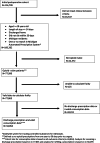Frailty Status, Not Just Age, is Associated With Postoperative Opioid Consumption: A Retrospective, Population-based Analysis
- PMID: 39711664
- PMCID: PMC11661759
- DOI: 10.1097/AS9.0000000000000496
Frailty Status, Not Just Age, is Associated With Postoperative Opioid Consumption: A Retrospective, Population-based Analysis
Abstract
Objective: To assess the relationship between postoperative opioid consumption and frailty status.
Background: Physiologic reserve can be assessed through both chronologic age as well as measures of frailty. Although prior studies suggest that older individuals may require less opioid following surgery, chronologic age, and frailty do not always align, and little is known regarding postoperative opioid consumption patterns by frailty.
Methods: We conducted a retrospective analysis of opioid-naïve adult patients undergoing common general, vascular, and gynecologic procedures across a statewide quality improvement program from November 6, 2017 to February 28, 2021. Our primary outcome was postoperative patient-reported opioid consumption within 30 days of surgery in oral morphine equivalents (OME). Our primary exposure was frailty status defined by the modified frailty index (mFi-5) criteria. Other covariates included patient demographic and clinical attributes, procedural factors, discharge opioid prescription size, and postoperative complications. Linear regression was performed to assess the association of frailty status and opioid consumption, stratified by age.
Results: In this cohort of 34,854 patients, 10,596 had an mFi-5 score of ≤1 and 3,635 had a score of >1. A score of >1 was associated with increased patient-reported opioid consumption (OMEs 3.3 greater; 95% CI = 1.5-5.1). This held true for individuals over 65 (OMEs 2.7 greater; 95% CI = 0.2-5.1). Frailty status, regardless of score, was negatively associated with an opioid prescription at discharge.
Conclusions: Frailty status is associated with increased opioid consumption after common operations. Future prescribing guidelines and outcomes analyses should consider this marker when reviewing opioid consumption data and related adverse outcomes.
Keywords: frailty; opioids; surgical patients.
Copyright © 2024 The Author(s). Published by Wolters Kluwer Health, Inc.
Conflict of interest statement
Disclosure: The authors declare that they have nothing to disclose.
Figures



Similar articles
-
Association of opioid exposure before surgery with opioid consumption after surgery.Reg Anesth Pain Med. 2022 Jun;47(6):346-352. doi: 10.1136/rapm-2021-103388. Epub 2022 Mar 3. Reg Anesth Pain Med. 2022. PMID: 35241626 Free PMC article.
-
Frailty status as a potential factor in increased postoperative opioid use in older adults.BMC Geriatr. 2021 Mar 18;21(1):189. doi: 10.1186/s12877-021-02101-4. BMC Geriatr. 2021. PMID: 33736611 Free PMC article.
-
The 2018 Chitranjan S. Ranawat, MD Award: Developing and Implementing a Novel Institutional Guideline Strategy Reduced Postoperative Opioid Prescribing After TKA and THA.Clin Orthop Relat Res. 2019 Jan;477(1):104-113. doi: 10.1007/s11999.0000000000000292. Clin Orthop Relat Res. 2019. PMID: 30794233 Free PMC article.
-
A Review of Inpatient Opioid Consumption and Discharge Prescription Patterns After Orthopaedic Procedures.J Am Acad Orthop Surg. 2020 Apr 1;28(7):279-286. doi: 10.5435/JAAOS-D-19-00279. J Am Acad Orthop Surg. 2020. PMID: 31633659 Review.
-
Prescription Patterns, Associated Factors, and Outcomes of Opioids for Operative Foot and Ankle Fractures: A Systematic Review.Clin Orthop Relat Res. 2022 Nov 1;480(11):2187-2201. doi: 10.1097/CORR.0000000000002307. Epub 2022 Jul 12. Clin Orthop Relat Res. 2022. PMID: 35901447 Free PMC article.
References
-
- Makary MA, Segev DL, Pronovost PJ, et al. . Frailty as a predictor of surgical outcomes in older patients. J Am Coll Surg. 2010;210:901–908. - PubMed
Grants and funding
LinkOut - more resources
Full Text Sources

